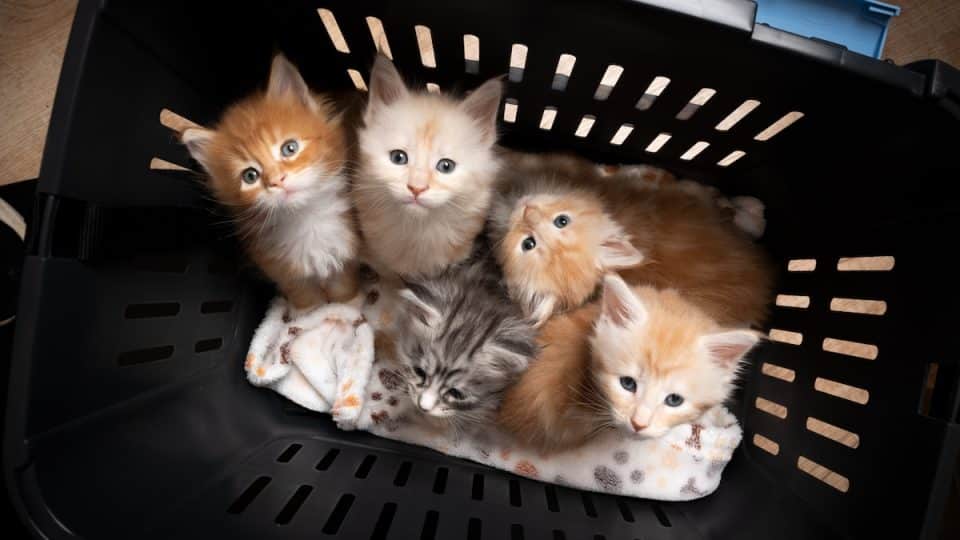Whether you’re a lifelong cat enthusiast or newly in love with the idea of welcoming a feline friend into your heart and home, first-time cat ownership is an exciting and rewarding journey for kitty and human alike. There are some unique challenges and considerations that come along with adopting a cat or kitten, and you might be wondering—what do first-time cat owners need to know?
With expert insights from feline behaviourists, we have the inside scoop on how you can best get ready for your new cat or kitten and how to set yourself up for a successful, trusting relationship filled with companionship, love, and joy.
Are You Ready to Be a First-Time Cat Owner?
If you’ve never lived with a cat or kitten before, you might believe the myth that cats are fiercely independent and crave solitude. There is some truth to that, but it’s not the full story. Yes, unlike their canine counterparts, cats experience less separation anxiety than dogs, and cats weren’t selectively bred to work for humans. But they still have emotional and social needs that require time and energy to meet.
“Good cat care goes beyond just providing the cat with food, water, and a litter box,” says Laura Cassiday, a certified cat behaviour consultant and founder of Pawsitive Vibes Cat Behavior & Training in the USA.
No, cats don’t need daily walks like dogs, but that doesn’t mean they’re a ‘hands off’ animal. Beyond having their basic needs met, cats and kittens also require play, enrichment, social interaction, and physical and mental exercise, especially if they’re indoor-only.
Here’s what you’ll need to commit to providing:
- a minimum of 20 minutes of play
- environmental enrichment like cat trees, scratching posts, window spots, and toys
- a cat-proofed home that’s safe for kitties
- grooming, including brushing, nail trims, and dental care
- training
- food, water, and a clean litter box
- regular vet care
Set Aside Time for Daily Play Sessions
For new cat owners, Cassiday recommends establishing a routine where you play with your cat or kitten at least twice a day, for 10 minutes each time.
As a species, cats are predators, and those predatory instincts for survival drive a lot of their behaviours. First-time cat parents need to commit to daily structured play to give cats and kittens the opportunity to pounce, chase, and hunt. Whether they’re a fan of interactive play with wand toys, or the choose-your-own-adventure allure of a cat tower, daily play makes cats and kittens less prone to destructive behaviours like shredding furniture, unstoppable zoomies in the wee hours of the morning, and drive-by ankle-biting.
If you’re someone who has a demanding work schedule and you’re away from home for many hours at a time, choosing to adopt two kittens or a bonded pair of cats can help give your feline friends more play opportunities. However, don’t expect them to fully entertain each other. Human-led, cat-centred interactive structured play is still essential, even in multi-cat households.
Provide Enrichment Opportunities
You’ll also need to make some changes to your home to accommodate your new feline friend.
The happiest, most well-adjusted cats and kittens are able to engage in all of their senses and safely act on their natural behaviours. This means before you bring your new cat or kitten home, set up vertical spaces for climbing, like cat shelves and cat towers, and a variety of places with a range of textures for them to scratch.
Cats need to scratch to maintain their claw health and exercise their muscles and tendons, and getting them the right scratching surfaces will keep them away from shredding human furniture. For cats and kittens who prefer horizontal scratching, get some scratching pads, especially ones made out of corrugated cardboard.
Many cats prefer vertically scratching and do best with a post. Choose one that is carpeted, or covered with sisal rope fibre, or made of soft wood. You can even try all three to give your cat or kitten many textures to choose from.
Sight enrichment is also essential, especially for indoor kitties. One of the easiest and most effective ways to do this is to set up a bird feeder or bird bath outside your cat’s favourite window.
For taste and scent enrichment, Cassiday believes food puzzles are the ultimate go-to item. They take little effort on your part to set up, and you can expect them to engage your cat or kitten for up to an hour. There are tons of ready-made cat food puzzles you can buy in pet stores or online, but if you’re just starting out, you can also DIY them using an egg carton, ice cube tray, or muffin tin and work your way up to something more challenging for your cat.

Andrey Sayfutdinov via iStock
Cat-Proof Your Home
Cats and curiosity go paw-in-paw. With that in mind, first-time cat owners can expect to see their new cat or kitten exploring their new living space as a way to acclimate themselves to its sights, sounds, and smells. Cats can turn anything into a toy (like, say, an easy-to-choke-on water bottle cap) and can squeeze themselves into dangerously tight spaces, so cat-proofing your home is essential to keep them safe.
What you can’t cat-proof, you’ll want to make off-limits. “Cats like to climb and jump on things, so a new cat parent should be prepared for this and decide where to draw boundaries, like kitchen counters,” says Stephen Quandt, CFTBS and founder of Feline Behavior Associates in the USA. You can use foil or scented products to keep your cat off—but you’ll also want to get good at providing food, enrichment, and distractions elsewhere.
Groom Your Cat
Grooming needs vary from cat to cat, depending on the type of hair your cat has. Long-haired cats might need daily brushing, short-haired cats might need brushing once or twice a week, and hairless cats require frequent bathing. Otherwise, they’ll leave oily, brown stains around your house.
Make it a point to get your cat or kitten used to nail trims and tooth brushing, and build up a positive association to grooming time by providing high-value treats as an incentive. Consulting or working with a feline behaviourist can help if you’re getting stuck.
Train Your Cat
“Most kittens and cats don’t need much in the way of training, and most come litter box trained,” Quandt says. Beyond getting them used to grooming like brushing and nail trims, other types of training first-time cat owners need to keep in mind include:
- getting your cat or kitten used to getting in and out of their carriers
- interactions with new people
- travelling short and long distances
Though cats aren’t usually trained in the way dogs are, you can teach a cat a variety of tricks, like paw, wave, and fetch. If it sounds fun, you can also train a cat to walk on a lead—and the earlier you start, the better your chances of success.
Meet Basic Food, Water, and Litter Needs
Quandt says generally, a healthy daily routine for a cat or kitten usually starts out with feeding them and refreshing their water bowls.
Many people feed their adult cats twice daily (young kittens eat three times) with wet food and dry kibble. Others free-feed kibble, or feed them more frequent small meals, so feeding routines vary by household.
Clean water, particularly giving your cat access to multiple water bowls or stations (like automatic water fountains), is also a must, and experts recommend multiple feeding and water stations for your cat because it mimics how cats get their food and water in nature.
Maintaining your cat or kitten’s litter box is also a part of a healthy daily routine. Quandt says the best practice is to scoop their litterbox at least twice a day and to have one litter box for each cat plus one extra.
Budget for Your New Cat
“Many pet parents get a cat or kitten for free or very little money but are not prepared for potential expenses, some of which can be predicted and some of which may not,” Dr Amber Carter, DVM, and owner of CatVetLife, says.
Depending on where you’re adopting or purchasing your new cat or kitten from, Dr Carter says beyond their first wellness visit, they may also need:
- microchipping (a legal requirement in the UK)
- booster vaccines
- rabies shots (only required if travelling outside of the UK)
- spay or neuter surgery
- faecal testing and viral testing
- deworming
- flea treatments
Though costs vary, basic vaccines, microchipping, and spaying or neutering typically cost between £250 and £350.
Kittens under one year old require more frequent vet visits, as do older cats or cats with pre-existing illnesses or health conditions, and those fees also add up.
First-time cat owners should prepare to spend between £440 and £1,440 on their new cat or kitten in their first year.
Dr Carter says pet insurance is a good way to help cover unplanned veterinary expenses. Most policies don’t cover pre-existing conditions, so it’s worth reading the fine print to make sure you’re aware of what is and isn’t covered.
First-Time Cat Owner Checklist
There are a lot of supplies to stock up on before you bring your new friend home. The core essential items you need for your cat or kitten as a first-time cat owner include:
- an appropriately sized cat carrier
- multiple food bowls and water bowls
- uncovered, extra large litter box pan
- unscented clumping litter
- wet and dry food formulated for their age and health needs
- cat bed and blankets
- cat tower or climbing tree
- vertical scratching post
- horizontal scratching pad or cardboard house
- cat-safe shampoo
- cat-safe wipes
- nail clippers
- grooming brush or comb
- interactive toys
- treats
- a collar
There’s also a lot of gear that you might find useful—though not strictly necessary when you’re getting started.
- automatic water fountain
- boxes and cave beds for hiding and playing
- heated cat bed
- cooling mats
- battery-operated toys
- food puzzles
- window perch or bed
- calming pheromone sprays or plug-ins
- harness and lead
- outdoor catio



